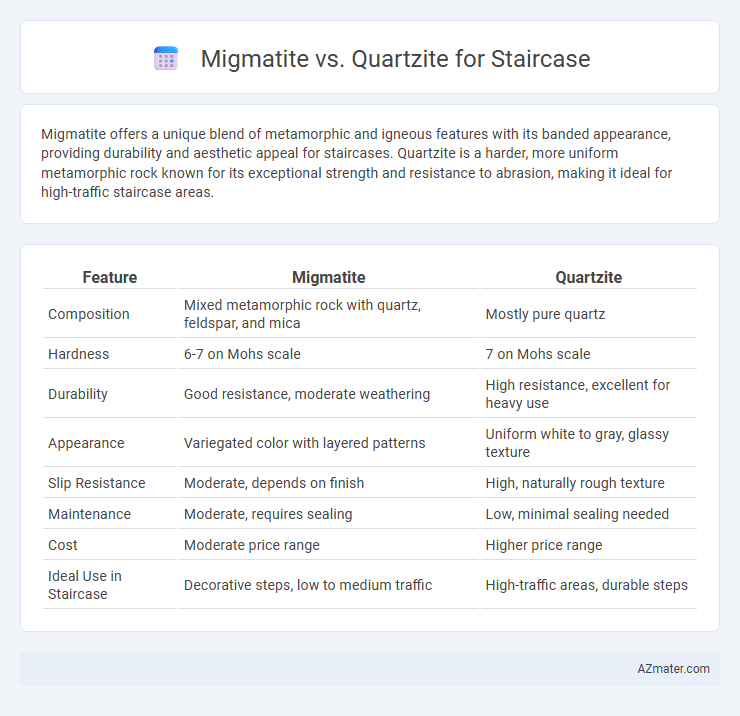Migmatite offers a unique blend of metamorphic and igneous features with its banded appearance, providing durability and aesthetic appeal for staircases. Quartzite is a harder, more uniform metamorphic rock known for its exceptional strength and resistance to abrasion, making it ideal for high-traffic staircase areas.
Table of Comparison
| Feature | Migmatite | Quartzite |
|---|---|---|
| Composition | Mixed metamorphic rock with quartz, feldspar, and mica | Mostly pure quartz |
| Hardness | 6-7 on Mohs scale | 7 on Mohs scale |
| Durability | Good resistance, moderate weathering | High resistance, excellent for heavy use |
| Appearance | Variegated color with layered patterns | Uniform white to gray, glassy texture |
| Slip Resistance | Moderate, depends on finish | High, naturally rough texture |
| Maintenance | Moderate, requires sealing | Low, minimal sealing needed |
| Cost | Moderate price range | Higher price range |
| Ideal Use in Staircase | Decorative steps, low to medium traffic | High-traffic areas, durable steps |
Introduction to Migmatite and Quartzite
Migmatite is a hybrid rock formed by the partial melting of metamorphic rocks, exhibiting a unique blend of igneous and metamorphic features with a patchy appearance that combines quartz, feldspar, and biotite minerals. Quartzite is a hard, non-foliated metamorphic rock derived from pure quartz sandstone, characterized by its durability, high resistance to abrasion, and consistent light to medium color variations. Both materials offer distinctive aesthetic and functional qualities, making them popular choices for staircases where strength and visual appeal are critical.
Geological Formation Differences
Migmatite forms through partial melting and metamorphism of igneous and metamorphic rocks, resulting in a composite rock with both igneous and metamorphic characteristics. Quartzite originates from the metamorphism of pure quartz sandstone under high pressure and temperature, leading to a dense, hard, and non-foliated rock primarily composed of quartz. The geological formation of migmatite creates variable textures and layers ideal for unique staircase aesthetics, while quartzite's uniform hardness offers consistent durability and smooth surfaces.
Physical Appearance and Texture
Migmatite features a unique blend of light and dark mineral bands with a swirling, marbled texture, offering a dynamic and natural aesthetic ideal for staircases. Quartzite displays a more uniform and granular texture with a glossy finish, characterized by its bright white or subtle pastel hues that create a sleek, elegant look. Both stones provide durability, but Migmatite's variegated appearance adds visual interest, while Quartzite's consistent texture offers a refined and polished surface.
Strength and Durability Comparison
Migmatite offers exceptional strength due to its mixed composition of metamorphic and igneous rocks, making it highly resistant to wear and structural stress for staircases. Quartzite, composed mainly of pure quartz, is extremely durable and resistant to scratching and weathering, ensuring long-lasting performance under heavy foot traffic. While both materials provide excellent durability, quartzite's superior hardness makes it more suitable for high-traffic staircases requiring minimal maintenance.
Slip Resistance and Safety Factors
Migmatite offers superior slip resistance for staircases due to its coarser, granular texture, reducing the risk of accidents in wet or high-traffic areas. Quartzite, while harder and more durable, tends to have a smoother surface that can become slippery when polished or wet, posing potential safety concerns. Choosing migmatite enhances staircase safety by providing better traction, especially in environments where slip hazards are a primary consideration.
Maintenance and Cleaning Needs
Migmatite stairs require regular sealing and gentle cleaning to prevent staining and surface damage, as their mixed mineral composition can be porous and prone to absorbing dirt. Quartzite, known for its hardness and non-porous nature, demands less frequent maintenance and resists stains and scratches, making it easier to clean with basic soap and water. Both materials benefit from non-abrasive cleaners, but quartzite's durability offers superior long-term performance for staircase applications.
Cost Implications for Staircase Projects
Migmatite and quartzite differ significantly in cost implications for staircase projects, with quartzite typically commanding higher prices due to its superior hardness and durability. Migmatite offers a more budget-friendly option while providing unique aesthetic patterns, but may require more maintenance over time. Choosing between the two depends on balancing initial investment with long-term performance and maintenance expenses for staircase installations.
Design Versatility and Aesthetic Appeal
Migmatite offers unique swirling patterns and a blend of light and dark minerals that create a dynamic visual effect ideal for bespoke staircase designs, enhancing both modern and classic interiors. Quartzite provides a consistent, compact texture with subtle sheen and natural quartz crystals that reflect light, adding elegance and durability to staircases in minimalist or upscale settings. Both materials boast excellent resistance to wear, making them not only visually striking but also practical choices for high-traffic staircase applications.
Environmental Impact and Sustainability
Migmatite and quartzite differ significantly in environmental impact and sustainability for staircase applications. Quartzite, being a naturally occurring metamorphic rock, offers high durability and requires minimal chemical processing, leading to lower carbon emissions during extraction and fabrication. Migmatite, while also natural, often undergoes more intensive quarrying and processing, potentially increasing its environmental footprint compared to quartzite's eco-friendlier production and longer lifespan.
Choosing the Right Stone for Your Staircase
Migmatite offers a unique blend of metamorphic textures with high durability and natural veining, making it ideal for staircases requiring both strength and aesthetic appeal. Quartzite provides exceptional hardness and resistance to wear, ensuring longevity and low maintenance for high-traffic staircases. Selecting between migmatite and quartzite depends on balancing visual texture preferences with the desired durability and slip resistance for safe, long-lasting staircase surfaces.

Infographic: Migmatite vs Quartzite for Staircase
 azmater.com
azmater.com